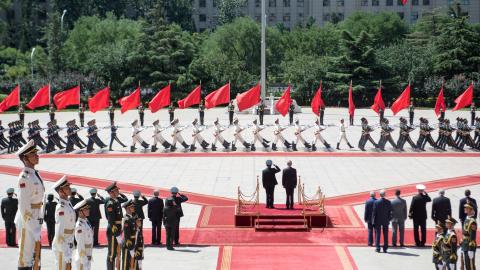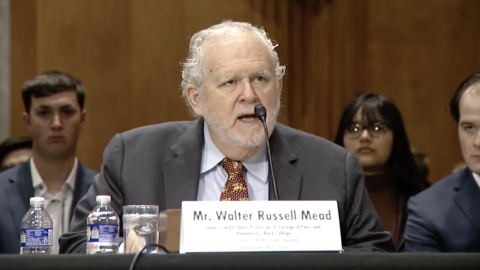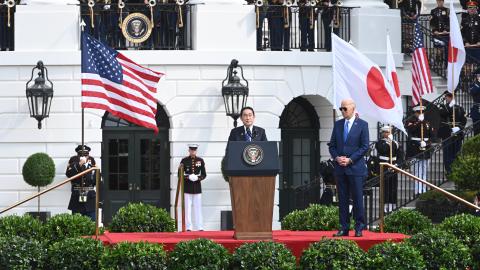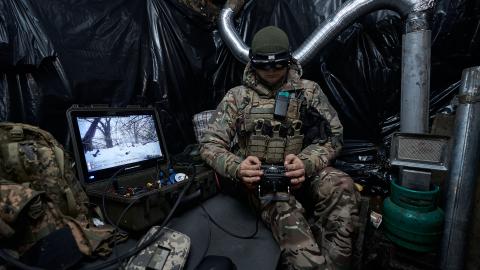Below Hudson Senior Fellow Can Kasapoğlu offers a military situation report about the war in Ukraine.
Executive Summary
- Russia made steady tactical gains, taking advantage of delays in aid from the United States.
- The passage of a long-awaited US military assistance package will boost Ukraine’s forces, which continue to target critical Russian aerial and naval assets.
- Amid continued heavy armor losses, Moscow reportedly increased its production capacity for main battle tanks.
1. Battlefield Assessment
This week Russia continued to make steady tactical gains, taking advantage of delays in aid from the United States. Ukraine’s degraded air defense capabilities and an artillery imbalance of roughly ten-to-one in Russia’s favor portend difficult weeks ahead. Now that the US Congress has passed a large military assistance package for Ukraine, the war-torn country is fighting to hold on until Western supplies arrive.
Moscow and Kyiv continued high-tempo combat operations this week, with the Russian military retaining the offensive upper hand. Last week witnessed significant positional clashes in Spirne, near Avdiivka, in the Robotnye bulge, and in Verbove. Russian forces also continued to batter the town of Chasiv Yar.
The Kremlin has prioritized a multifront advance to stress Ukrainian fortifications, hoping that prolonged attrition will open multiple breaches in Ukraine’s battered lines of defense. Moscow has used artillery from North Korea and heavy glide bombs to gain advantages on the battleground. On the southern and eastern front lines, Russian combat formations have registered confirmed tactical advances.
Alongside its mounting ground offensives, Russia also continued to launch aerial strikes, inflicting heavy civilian casualties and damage to critical infrastructure in Ukraine. In line with prior operational trends, recent Russian drone and missile attacks focused primarily on Dnipro, Odesa, and Kherson, killing or wounding dozens of civilians, including children. The Russian military continues to launch Iranian-made drones and Soviet-era missiles into Ukrainian population centers at a pressing tempo. Ballistic missiles transferred from Pyongyang have also been pounding Ukraine for weeks.
Kyiv is countering by continuing to target critical Russian assets. On April 20, Ukraine struck the Russian naval base in Sevastopol in occupied Crimea, heavily damaging naval platforms and the facility itself. Reports suggest that these strikes hit the Russian Navy’s oldest active-duty vessel, the Kommuna, which served the country in the First and Second World Wars. Ukraine’s strikes inflicted sufficient damage on the craft to force its retirement.
This loss will hurt Russia’s already damaged Navy, as the Kommuna was more than a museum piece. The vessel, a twin-hull catamaran, regularly participated in submarine trials and seabed warfare operations. The platform possessed a large aperture that it could use to launch and recover miniature rescue submarines or lift sunken vessels from the seafloor. With the Kommuna out of action, Russia’s Black Sea Fleet has lost another critical capability, putting its Improved Kilo–class submarines in greater danger should they need a seabed rescue.
Ukraine continues to target the Black Sea Fleet, but Kyiv is increasingly also targeting Moscow’s aerial capabilities. Last week, Ukraine continued pinpoint strikes on Russian military bases.
On April 17, Ukraine attacked Dzhankoi in occupied Crimea. Available evidence indicates that Kyiv conducted a two-wave strike using ATACMS tactical ballistic missiles against Russian helicopter groupings and S-400 strategic surface-to-air missiles (SAMs). Ukrainian forces’ strike on Dzhankoi also destroyed the Fundament-M, a rare aerospace surveillance complex that Moscow had used as a command and control (C2) node to synchronize its air defenses.
The Kremlin also lost a valuable Tu-22M3 long-range tactical bomber this week. While Russian reports claimed that the aircraft crashed while returning from a mission, Commander of the Ukrainian Air Force Mykola Oleshchuk suggested that the air force downed the plane in a successful anti-aircraft operation 185 miles inside Russia, in close cooperation with the Defense Intelligence of Ukraine (GUR). Ukraine likely used an S-200, a Cold War–era, very-long-range strategic air defense system, to down the Russian craft.
Ukraine also continued its campaign to inflict heavy damage on Russia’s economy via highly attritional asymmetric warfare. Last week, in an attempt to disrupt the Kremlin’s oil industry, Ukrainian drones rained down fire on Russian oil depots and power plants. Kyiv simultaneously attacked eight regions in Russia, including Belgorod, Tula, Kursk, and Moscow, with long-range drones.
This report continues to monitor drone-on-drone combat in Ukraine and its impact on the future of warfare. Last week, Ukrainian first-person-view (FPV) drones continued to target Russian robotic ground warfare assets. To adapt to an increasingly digitalized battlefield, Russia began a significant effort to bolster its counter-drone capabilities to supplement its already high rate of drone production, reports suggest.
2. Long-Awaited US Military Aid Will Boost Ukraine
As Ukraine’s fortifications grow fragile and the nation’s military resources become increasingly scarce, Congress’s passage of a bill to send further military aid to Ukraine, Israel, and Taiwan will bolster Kyiv’s ability to hold back further Russian advances—and potentially to conduct a successful counteroffensive. The $60 billion US aid package comes at a crucial moment in Ukraine’s war effort.
In February 2024, the Ukrainian military withdrew from the long-besieged city of Avdiivka, ceding significant territory to Russian forces. Ukraine’s limited resources and Russia’s artillery advantage made the retreat all but inevitable. Ukrainian combat formations continue to face ammunition shortages, rationing artillery rounds and leaving fire-support formations unable to back the infantry and lines of defense. This weakness prompted Russia to assault Avdiivka and likely motivates Moscow’s current push toward Chasiv Yar.
While the content of the US assistance package has not yet been made public, military necessity suggests that it will involve artillery rounds, precision munitions, and interceptors for air defenses. Follow-on aid programs may include advanced long-range strike assets, such as high-end munitions for Ukraine’s future F-16 fleet, as well as the longer-range and more destructive variants of the ATACMS tactical ballistic missile baseline. When the US assistance arrives, it will help Ukraine retain its territory and protect its civilians and critical infrastructure.
But the most significant boost that increased Western aid is likely to provide is to the morale of the Ukrainian Armed Forces. To fully exploit the benefits of the forthcoming weapons, Kyiv should use the resources it acquires to brace for a long war and enhance training for its forces. Europe should also ramp up arms production to create a sustainable supply base and reduce Kyiv’s dependency on the United States.
3. Russia Reportedly Increases Its Production Capacity for Main Battle Tanks
According to statements from Russian Defense Minister Sergei Shoigu during a performance assessment visit to a main battle tank factory, the Kremlin is ramping up production of battle tanks and heavy flamethrower systems in multiple facilities throughout the nation, including at the Omsk plant in Siberia. This effort will likely help Russia replenish its depleted tank stocks, allowing Moscow to conduct a broader and more robust ground offensive in Ukraine.
Despite its losses, the Russian military still operates up to 3,000 main battle tanks in Ukraine, making much of the battleground a cemetery of steel. Yet over two years after commencing its invasion, Russia has lost some 15,000 principal land warfare platforms, including heavy armor and artillery pieces. Having resorted to exhuming decrepit platforms from Soviet-era storage, the Kremlin continues to field relics, including T-54s, T-55s, and T-64s, to boost its war effort. Current projections show that by 2025, Russia may exhaust all the Cold War–era tanks in its storage facilities. This is why boosting the production rate of modernized main battle tanks remains a high priority for the Russian Defense Ministry.














